Page 181 of 602
3-84 Features and controls
3
NOTE�
The drive mode can be switched while driving or stopped.
Drive mode indicatorNormally the indicator illuminates when the ignition switch is
turned to the “ON” position or the operation mode is put in
ON, and then the drive mode is displayed a few seconds after
the engine is started.
Drive mode
Display
Ty p e 1
Ty p e 2
2WD
4WD AUTO
4WD LOCKCAUTION
!�
Do not operate the drive mode-selector with the
front wheels spinning on a snowy road or in similar
conditions. The vehicle could lunge in an unexpected
direction.
�
Driving on dry, paved roads in “4WD LOCK” mode
causes increased fuel consumption, noise, and pre-
mature tire wear.
�
Do not drive with the tires spinning in “2WD” mode.
Doing so could generate heat in the drive-system
components.
Type 1 Type 2
Drive
Mode
Drive mode
indicator
“4WD” indicator
“LOCK” indicator
2WD OFF OFF
4WD AUTO ON OFF
4WD LOCK ON ON
BK0120400US.book 84 ページ 2010年7月2日 金曜日 午後2時36分
Page 182 of 602
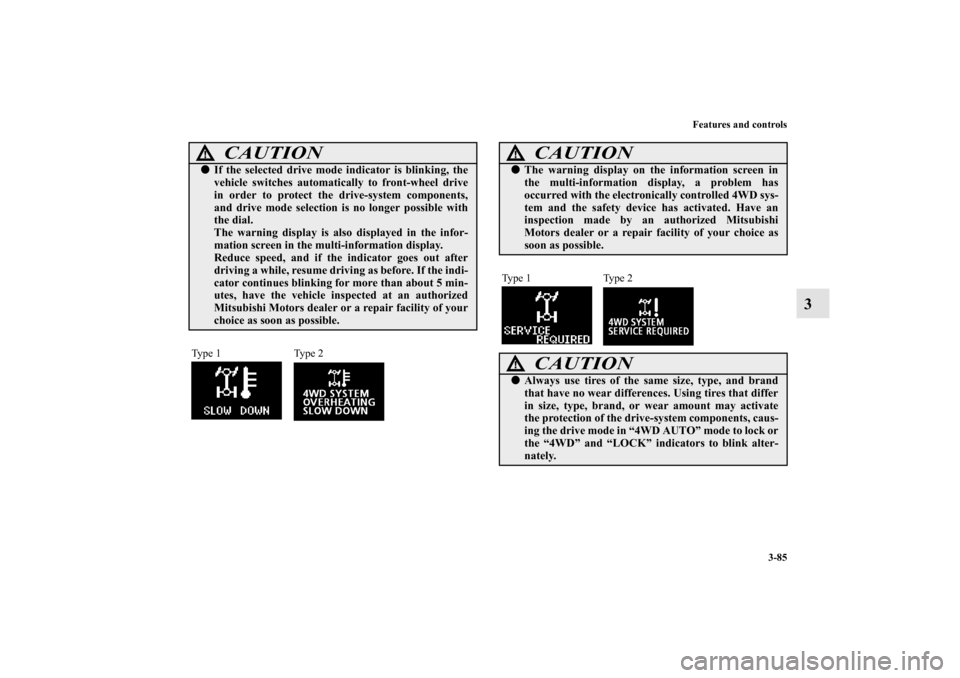
Features and controls
3-85
3
CAUTION
!�If the selected drive mode indicator is blinking, the
vehicle switches automatically to front-wheel drive
in order to protect the drive-system components,
and drive mode selection is no longer possible with
the dial.
The warning display is also displayed in the infor-
mation screen in the multi-information display.
Reduce speed, and if the indicator goes out after
driving a while, resume driving as before. If the indi-
cator continues blinking for more than about 5 min-
utes, have the vehicle inspected at an authorized
Mitsubishi Motors dealer or a repair facility of your
choice as soon as possible.Type 1 Type 2
CAUTION
!�The warning display on the information screen in
the multi-information display, a problem has
occurred with the electronically controlled 4WD sys-
tem and the safety device has activated. Have an
inspection made by an authorized Mitsubishi
Motors dealer or a repair facility of your choice as
soon as possible.Ty p e 1 Ty p e 2
CAUTION
!�Always use tires of the same size, type, and brand
that have no wear differences. Using tires that differ
in size, type, brand, or wear amount may activate
the protection of the drive-system components, caus-
ing the drive mode in “4WD AUTO” mode to lock or
the “4WD” and “LOCK” indicators to blink alter-
nately.
BK0120400US.book 85 ページ 2010年5月12日 水曜日 午前10時50分
Page 187 of 602
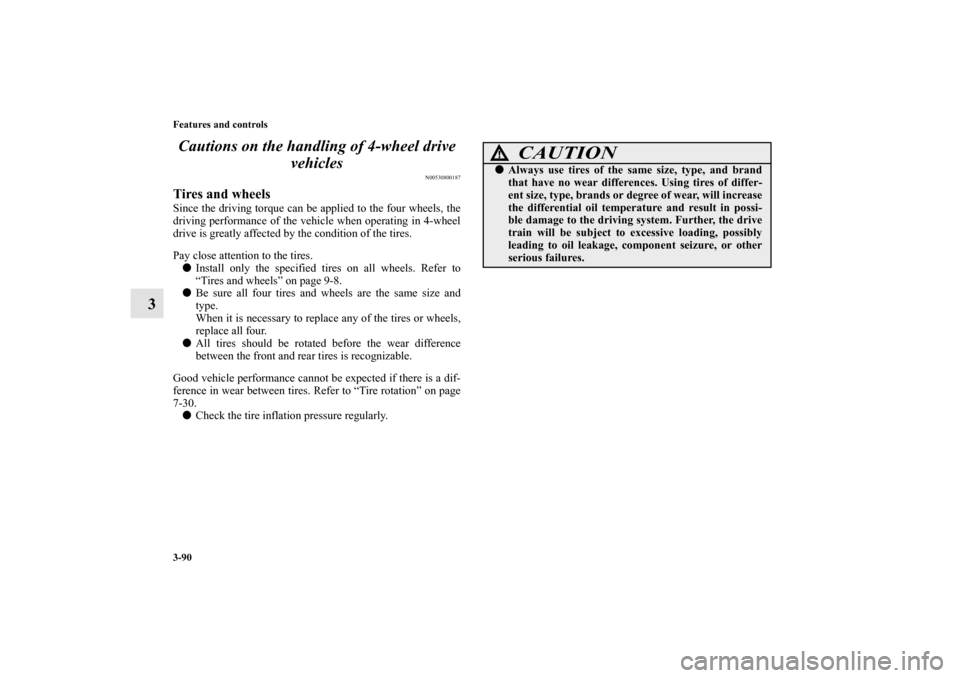
3-90 Features and controls
3Cautions on the handling of 4-wheel drive
vehicles
N00530800187
Tires and wheelsSince the driving torque can be applied to the four wheels, the
driving performance of the vehicle when operating in 4-wheel
drive is greatly affected by the condition of the tires.
Pay close attention to the tires.
�Install only the specified tires on all wheels. Refer to
“Tires and wheels” on page 9-8.
�Be sure all four tires and wheels are the same size and
type.
When it is necessary to replace any of the tires or wheels,
replace all four.
�All tires should be rotated before the wear difference
between the front and rear tires is recognizable.
Good vehicle performance cannot be expected if there is a dif-
ference in wear between tires. Refer to “Tire rotation” on page
7-30.
�Check the tire inflation pressure regularly.
CAUTION
!�Always use tires of the same size, type, and brand
that have no wear differences. Using tires of differ-
ent size, type, brands or degree of wear, will increase
the differential oil temperature and result in possi-
ble damage to the driving system. Further, the drive
train will be subject to excessive loading, possibly
leading to oil leakage, component seizure, or other
serious failures.
BK0120400US.book 90 ページ 2010年5月12日 水曜日 午前10時50分
Page 188 of 602
Features and controls
3-91
3
To w i n g
Jacking up a 4-wheel drive vehicle
CAUTION
!�Do not tow 4-wheel drive vehicles with the front or
rear wheels on the ground (Type A or Type B) as
illustrated. This could result in damage to the driv-
etrain, or unstable towing.
If you tow 4-wheel drive vehicles, use Type C or
Type D equipment.
�Even in “2WD” mode, the vehicle cannot be towed
with the front or the rear wheels on the ground.
WA R N I N G
!�Do not crank the engine while jacking up the vehi-
cle.
The tire on the ground may turn and the vehicle
may roll off the jack.
CAUTION
!
BK0120400US.book 91 ページ 2010年5月12日 水曜日 午前10時50分
Page 194 of 602
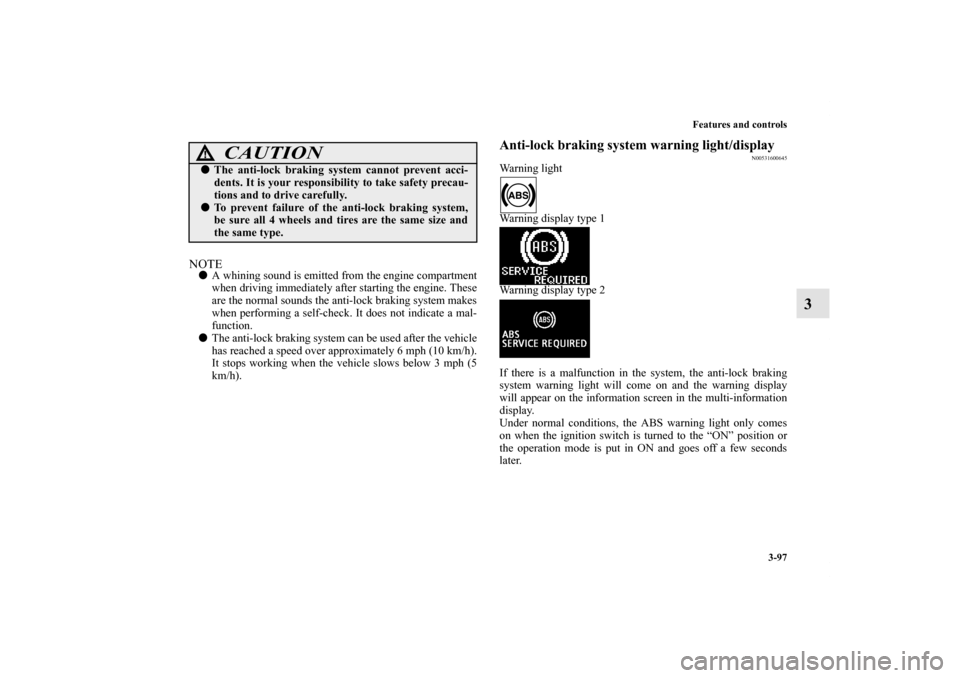
Features and controls
3-97
3
NOTE�A whining sound is emitted from the engine compartment
when driving immediately after starting the engine. These
are the normal sounds the anti-lock braking system makes
when performing a self-check. It does not indicate a mal-
function.
�The anti-lock braking system can be used after the vehicle
has reached a speed over approximately 6 mph (10 km/h).
It stops working when the vehicle slows below 3 mph (5
km/h).
Anti-lock braking system warning light/display
N00531600645
Warning light
Warning display type 1
Warning display type 2
If there is a malfunction in the system, the anti-lock braking
system warning light will come on and the warning display
will appear on the information screen in the multi-information
display.
Under normal conditions, the ABS warning light only comes
on when the ignition switch is turned to the “ON” position or
the operation mode is put in ON and goes off a few seconds
later.
CAUTION
!�The anti-lock braking system cannot prevent acci-
dents. It is your responsibility to take safety precau-
tions and to drive carefully.�To prevent failure of the anti-lock braking system,
be sure all 4 wheels and tires are the same size and
the same type.
BK0120400US.book 97 ページ 2010年5月12日 水曜日 午前10時50分
Page 199 of 602
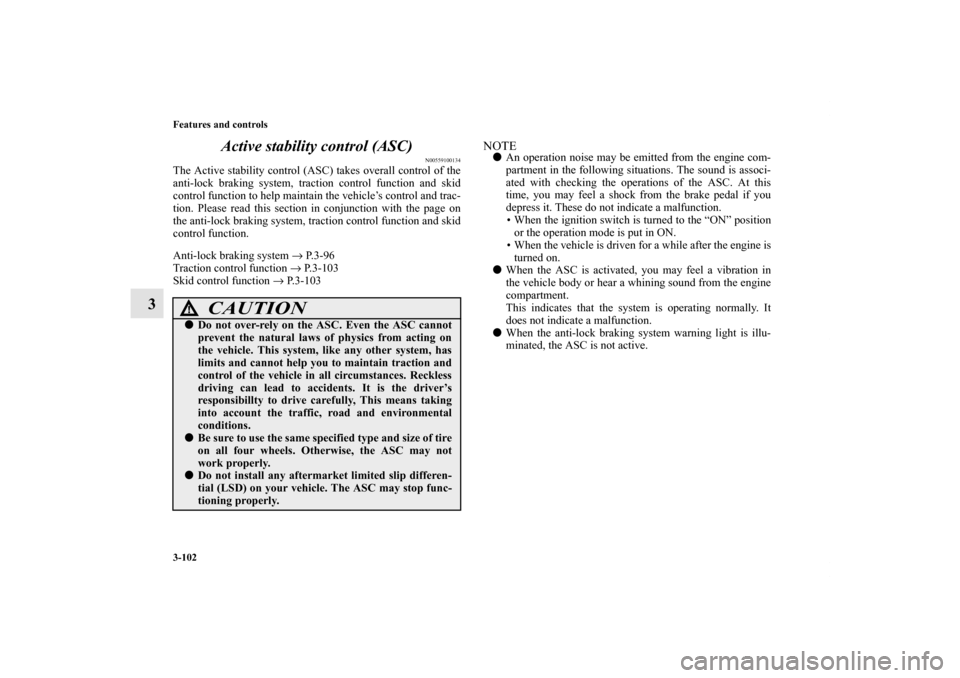
3-102 Features and controls
3Active stability control (ASC)
N00559100134
The Active stability control (ASC) takes overall control of the
anti-lock braking system, traction control function and skid
control function to help maintain the vehicle’s control and trac-
tion. Please read this section in conjunction with the page on
the anti-lock braking system, traction control function and skid
control function.
Anti-lock braking system → P. 3 - 9 6
Traction control function → P. 3 - 1 0 3
Skid control function → P. 3 - 1 0 3
NOTE�An operation noise may be emitted from the engine com-
partment in the following situations. The sound is associ-
ated with checking the operations of the ASC. At this
time, you may feel a shock from the brake pedal if you
depress it. These do not indicate a malfunction.
• When the ignition switch is turned to the “ON” position
or the operation mode is put in ON.
• When the vehicle is driven for a while after the engine is
turned on.
�When the ASC is activated, you may feel a vibration in
the vehicle body or hear a whining sound from the engine
compartment.
This indicates that the system is operating normally. It
does not indicate a malfunction.
�When the anti-lock braking system warning light is illu-
minated, the ASC is not active.
CAUTION
!�Do not over-rely on the ASC. Even the ASC cannot
prevent the natural laws of physics from acting on
the vehicle. This system, like any other system, has
limits and cannot help you to maintain traction and
control of the vehicle in all circumstances. Reckless
driving can lead to accidents. It is the driver’s
responsibillty to drive carefully, This means taking
into account the traffic, road and environmental
conditions.�Be sure to use the same specified type and size of tire
on all four wheels. Otherwise, the ASC may not
work properly.�Do not install any aftermarket limited slip differen-
tial (LSD) on your vehicle. The ASC may stop func-
tioning properly.
BK0120400US.book 102 ページ 2010年5月12日 水曜日 午前10時50分
Page 202 of 602
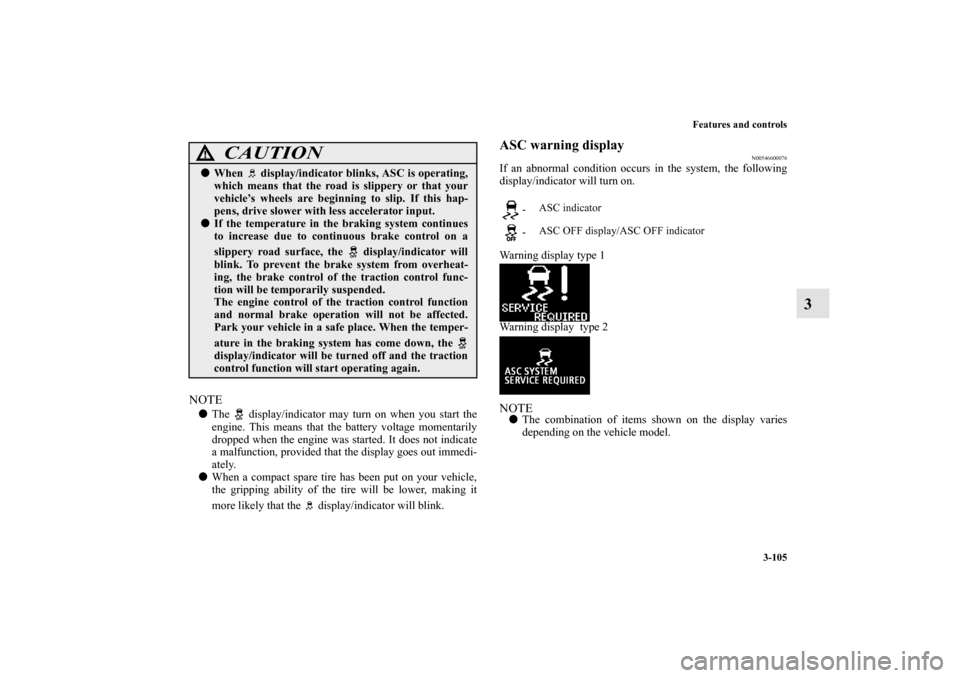
Features and controls
3-105
3
NOTE�The display/indicator may turn on when you start the
engine. This means that the battery voltage momentarily
dropped when the engine was started. It does not indicate
a malfunction, provided that the display goes out immedi-
ately.
�When a compact spare tire has been put on your vehicle,
the gripping ability of the tire will be lower, making it
more likely that the display/indicator will blink.
ASC warning display
N00546600076
If an abnormal condition occurs in the system, the following
display/indicator will turn on.
Warning display type 1
Warning display type 2NOTE�The combination of items shown on the display varies
depending on the vehicle model.
CAUTION
!�When display/indicator blinks, ASC is operating,
which means that the road is slippery or that your
vehicle’s wheels are beginning to slip. If this hap-
pens, drive slower with less accelerator input.�If the temperature in the braking system continues
to increase due to continuous brake control on a
slippery road surface, the display/indicator will
blink. To prevent the brake system from overheat-
ing, the brake control of the traction control func-
tion will be temporarily suspended.
The engine control of the traction control function
and normal brake operation will not be affected.
Park your vehicle in a safe place. When the temper-
ature in the braking system has come down, the
display/indicator will be turned off and the traction
control function will start operating again.
-ASC indicator
-ASC OFF display/ASC OFF indicator
BK0120400US.book 105 ページ 2010年5月12日 水曜日 午前10時50分
Page 257 of 602
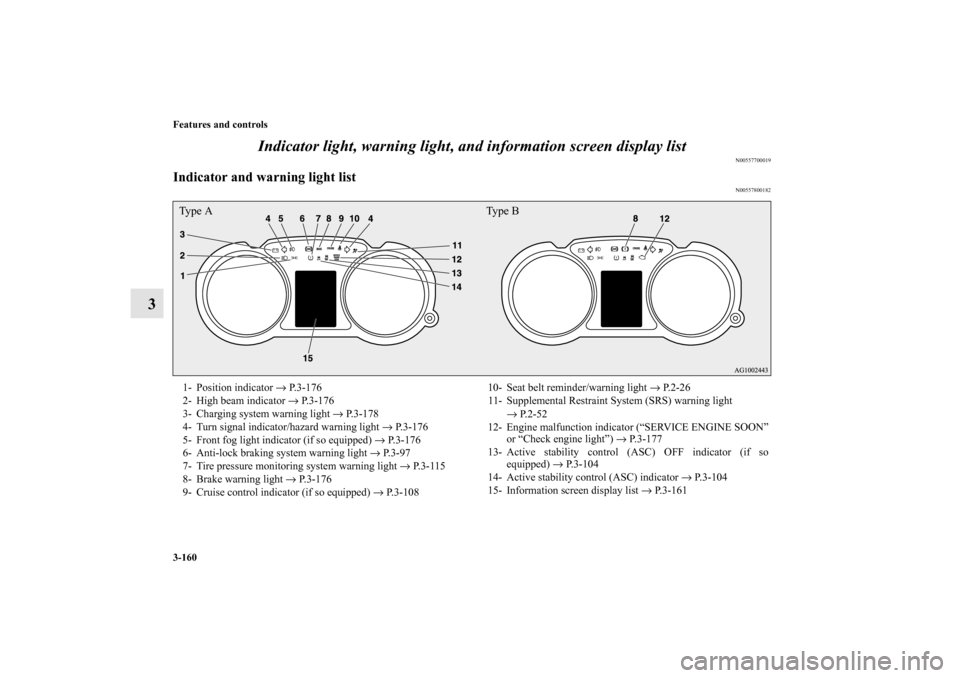
3-160 Features and controls
3Indicator light, warning light, and information screen display list
N00557700019
Indicator and warning light list
N00557800182
Type A Type B1- Position indicator → P.3-176
2- High beam indicator → P.3-176
3- Charging system warning light → P.3-178
4- Turn signal indicator/hazard warning light → P.3-176
5- Front fog light indicator (if so equipped) → P.3-176
6- Anti-lock braking system warning light → P.3-97
7- Tire pressure monitoring system warning light → P. 3 - 1 1 5
8- Brake warning light → P. 3 - 1 7 6
9- Cruise control indicator (if so equipped) → P.3-10810- Seat belt reminder/warning light → P. 2 - 2 6
11- Supplemental Restraint System (SRS) warning light
→ P.2-52
12- Engine malfunction indicator (“SERVICE ENGINE SOON”
or “Check engine light”) → P.3-177
13- Active stability control (ASC) OFF indicator (if so
equipped) → P.3-104
14- Active stability control (ASC) indicator → P.3-104
15- Information screen display list → P. 3 - 1 6 1
BK0120400US.book 160 ページ 2010年5月12日 水曜日 午前10時50分